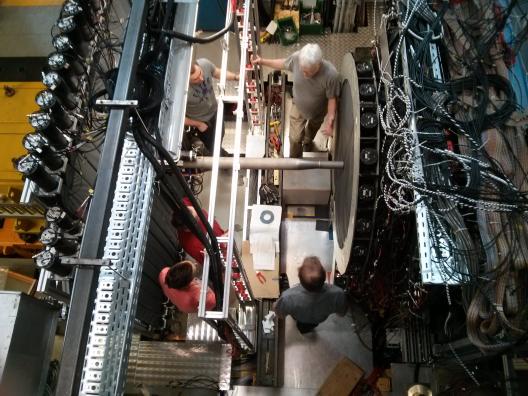The WASA Experiment
The accelerator experiment WASA-at-COSY is utilized for studies on the production and on decays of light mesons, especially pions and η-mesons. For this purpose, the accelerator beam (consisting of protons or deuterons) is brought to collision with an pellet target (H2 or D2). The produced particles resp. their decay particles are measured in dedicated detector parts. WASA was originally built at the CELSIUS accelerator in Uppsala, Sweden, but moved after several improvements to the COSY accelerator at Forschungszentrum Jülich, enabling experiments with considerably higher beam energies.
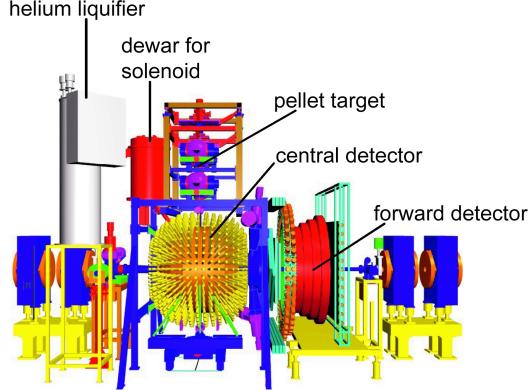
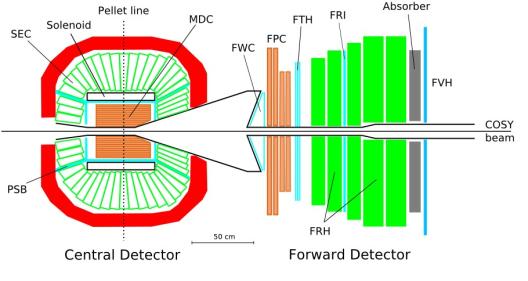
During these scattering experiments beam particles with high energies of a few GeV hit target particles. During these collisions the mesons can be produced. Additionally, the beam and pellet particles move further, fuse into heavier nuclei or break up. The analysis of the measured data relies on the detection and reconstruction of all these particles within the detector.
The forward detector records all particles with large longitudinal momenta which are mainly beam and target particles as well as their break up and fusion products. These are usually protons, deuterons and helium nuclei. The forward detector is assembled out of different specialized detector planes.
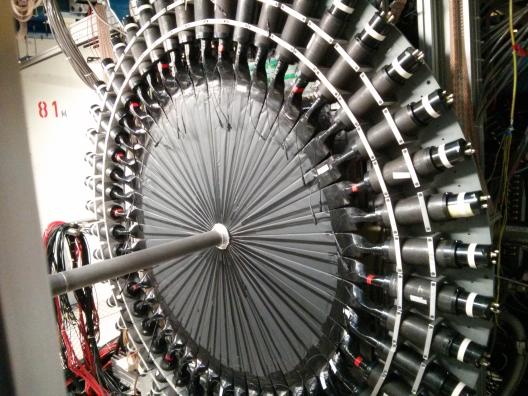
The central detector encloses the interaction point, where beam and target collide and the mesons are produced. This detector part records the decay products of these mesons, mainly photons, electrons, positrons, and charged pions. Similar to the forward part, the central detector consists of different planes. Additionally, a superconducting solenoid generates a magnetic field, which bends the trajectories of charged particles. The radii of curvature allow for the reconstruction of the particle momenta.
The pellet target system was specially developed to meet the requirements of the WASA experiment. In contrast to the more common cluster-jet targets, the pellet beam consists of droplets of frozen hydrogen or deuterium with diameters of around 25µm. Such targets provide high target thicknesses and a well-located interaction region with the accelerator beam. Moreover, the small divergence of the pellet beam requires only narrow feed-throughs through the detector. Acceptance wholes can be minimized and WASA achieves almost a 4π acceptance for particles.
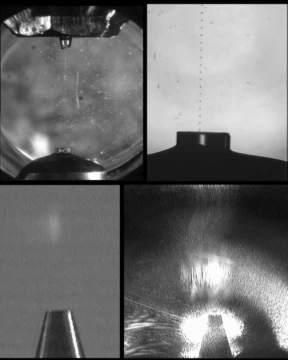
The adjacent animation shows the pellet target during operation. In the upper left part, the pellet beam can be seen between the nozzle and the vacuum injection. The displayed area spans ca. 1 cm. The upper right part shows a detail enlargement of the beam under stroboscope light visualizing single pellets. The lower animations show the pellet beam above the skimmer which cuts out a narrow part of the beam.
Our research group analyzed different measurements conducted with the WASA-at-COSY experiment. One focus was on the decay η → π0 + e+ + e– which is highly suppressed due to conservation laws within the standard model. An evidence for this decay gives therefore an indication of the violation of these conservation laws or of physics beyond the standard model.
Beside the decays of η-mesons, the production of light mesons represents an interesting research topic. Among others, investigated topics like meson-nucleon resp. meson-nucleus interactions and that recently observed dibaryon d*(2380) were discussed.
More informationen can be found on the official WASA-at-COSY-Experiment website.
